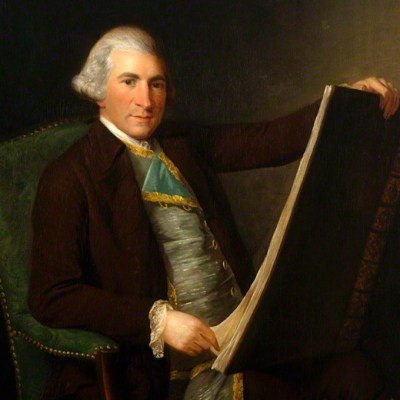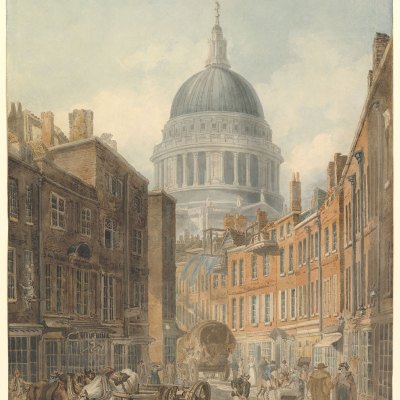‘We speak of the sky as a vault, a dome,’ wrote W.R. Lethaby in his recondite but influential book of 1891, Architecture, Mysticism and Myth; ‘It may be said that at great periods of architecture ceilings were always skies.’ He was thinking of, among other things, the mosaic-covered vaults and domes of Byzantine churches on which, in addition to Christ Pantocrator and figures of apostles and the saints, six-winged seraphs flutter against a glittering gold sky. This was the vision of John Francis Bentley for Westminster Cathedral, the great church he had designed for London and the supreme masterpiece of the late-Victorian Byzantine Revival – although Bentley never saw any mosaics fixed before his death in 1902. And it was the vision of its second incumbent, Cardinal Bourne, who later sent Bentley’s successor, John Marshall, and the artist Gilbert Pownall off to Monreale, to the Palatine Chapel in Palermo, to Ravenna, and elsewhere and set up a mosaic workshop in the cathedral in 1930.
When opened in 1903, the interior of the cathedral was a vast, sublime, unadorned structure of millions of London stock bricks and grey concrete saucer domes: ‘Cardinal Vaughan’s railway station’. But it was always intended to embellish the walls with gorgeous marbles and to cover the soon soot-stained vaults with mosaic. It was always known that this work would take a century or more, and it began, sensibly, with decorating some of the side chapels that soon had reredoses and other furnishings installed but whose concrete vaults remained bare. The first to be done was the Chapel of the Holy Souls, designed by Bentley’s friend William Christian Symons, who faithfully realised the architect’s vision of ‘the vault […] covered with silver mosaic, glazed with golden green, and enriched with wreaths of green and gold […] severe and very Greek’ in character. The latest to be completed is the adjacent Chapel of St George and the English Martyrs, with mosaics and intarsia marble panels by Tom Phillips.
This has not been an easy process. The campaign to complete the whole interior with marble and mosaic has been interrupted by occasional public protests at the quality of some of the work, while there has been a long-running tension between Bentley’s vision of an interior essentially inspired by the best Byzantine models and the desire of several artists to do something different, to achieve a modern expression in the mosaic tradition, while conforming to necessary iconographic and representational imperatives. In consequence, there have been some embarrassingly pretentious and inappropriate smaller mosaic panels installed in recent decades as well as some conspicuous triumphs.
The most harmonious, if not the most imaginative mosaics are, on the whole, those that conform to Byzantine precedents, with small-scale detail and the vaults made interesting and varied in the light by having the tesserae fixed by the direct method. Some are surprisingly late in date. In 1926, having been to Sicily and elsewhere, Gilbert Pownall began to prepare designs for completing the Lady Chapel. The result, finished in 1935, is convincingly neo-Byzantine and appropriate in scale, with good colours and well-drawn angels and other figures. Much less successful was Pownall’s mosaic in the tympanum of the arch over the sanctuary – a most awkward shape – which provoked protest and was almost removed.
Rather different is the treatment of the balancing Blessed Sacrament Chapel. Following the establishment of the Cathedral Art Advisory Committee in 1953, which clearly wanted something just a little more modern-looking, the commission went to the Russian-born artist Boris Anrep, who produced something convincingly Orthodox, if with paler colours. Next came St Paul’s Chapel, which Anrep passed on to his long-time assistant, Justin Vulliamy. Here the figures are much larger and cruder, while the vault itself is not the sky, or heaven, but treated as a stretched patterned velarium or awning, all in pale colours. After this was completed in 1965, hardly any new mosaics were added in the cathedral until the new millennium – perhaps for good reason.
Ceiling of the Chapel of St George and the English Martyrs, Westminster Cathedral. designed by Tom Phillips and dedicated in 2016. © Mazur/catholicnews.org.uk

The committee then asked Christopher Hobbs to tackle St Joseph’s Chapel. Completed in 2006, the mosaics here are Byzantine in inspiration, without pedantry. Particularly successful is the vault, covered with an intricate wattle or basket-weave pattern. Even better is Hobbs’ treatment of the adjacent Chapel of St Thomas of Canterbury in the north transept, which also serves as the Vaughan Chantry. Finished by 2005 when the body of the eponymous Cardinal was returned, this small space has a particularly beautiful deep-blue mosaic vault, as well as rich and intricate coloured patterns.
Then came the completion of the Chapel of St George and the English Martyrs by Tom Phillips. It is a very imaginative conception. Here the vault is, again, deep blue, against which hover bright flame-like forms bearing the names of martyrs. The problem is that here – unlike in the Vaughan Chantry – the blue hardly glitters. An article by the cathedral architect, Michael Drury, explains that this sky represents the ‘dark night of the Church of England in the period of the persecution of Catholics’, which does not seem very ecumenical, as well as being aesthetically unfortunate. The arches supporting the vault are, however, happily decorated with leaf-like forms and intricate stylised lettering (less happy is the mechanical sans-serif lettering on the intarsia wall representing Tyburn, for which there can be no excuse in a building with Eric Gill’s glorious Stations of the Cross).
The Chapel of St Andrew and the Saints of Scotland, Westminster Cathedral, designed by Robert Weir Schultz and completed in 1915. Photo: the author

The new decorative scheme in St George’s Chapel was dedicated in 2016, almost exactly a century after the completion of what is often regarded as the most successful of all the chapels, that of St Andrew and the Saints of Scotland. Donated by Lord Bute, it was the creation of the Arts and Crafts architect Robert Weir Schultz, who had extensively studied the Byzantine churches of Greece at the suggestion of his friend Lethaby. But Schultz did not copy Byzantine precedents; as he wrote, ‘The mere form of the figures, the types of the costumes, the archaeological accessories, all belong to a time and a state of things that is gone from us, and lives only as history.’ So the mosaic vault here, carried out from cartoons made by George Jack, is unlike anything else. At a lower level, there are views of cities associated with St Andrew while, above, the gold tesserae are arranged in a series of overlapping semi-circles, like fish-scales, creating a strong repetitive pattern achieved by texture and light.
Together with the other fittings and furniture made by Schultz’s colleagues in the Art Workers’ Guild, St Andrew’s Chapel is a triumphant success. In designing an earlier chapel in the Byzantine manner in Regent’s Park, Schultz recalled the influence of Lethaby’s book and how ‘into it went a pavement like the sea and a ceiling like the sky, as an accepted tradition’. The sea creatures inlaid in marble on the floor of St Andrew’s Chapel recall the saint’s first profession, while the sky, the golden vault, must be heaven. If ever the high vaults of Westminster Cathedral, dark and mysterious, are tackled – and I cannot help fearing they are best left alone – it is surely Schultz’s idea of a golden sky rather than Phillips’ representation of a dark night which should be followed.
From the January issue of Apollo. Preview and subscribe here.



